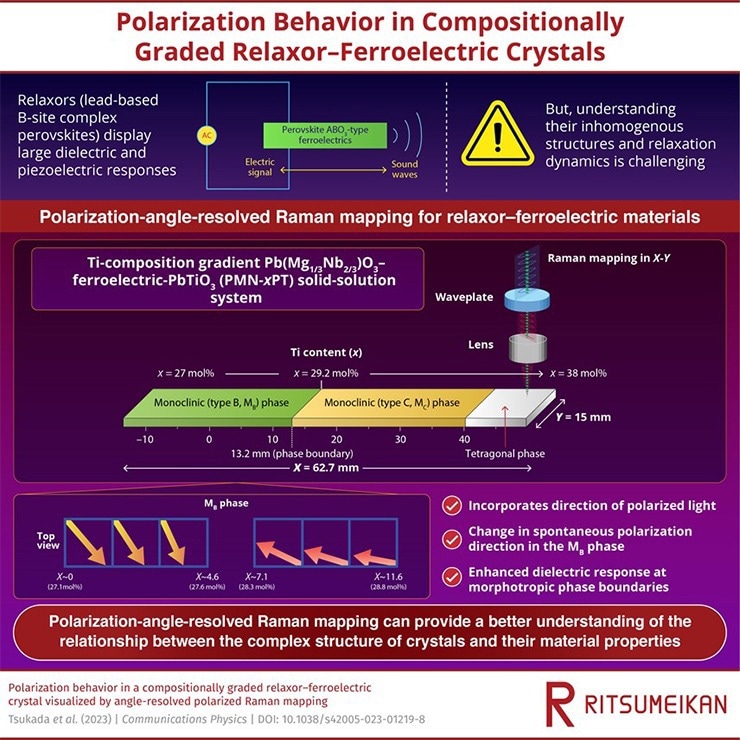Relaxor–ferroelectric materials are high-performance ultrasound generation elements exhibiting large dielectric responses owing to their complex structures. Recently, researchers from Japan made use of a novel polarization-angle-resolved Raman microscope developed by them to investigate the electric polarization distribution in lead magnesium niobate-lead titanate crystals, a piezoelectric material used in ultrasound equipment and fish finder probes. The information obtained on electric polarization holds the potential for performance enhancement of next-generation ultrasound diagnostic devices.

Image Credit: Ritsumeikan University, Japan
The exploitation of polarization or charge separation in ferroelectric materials has led to remarkable advances in various fields, such as the development of new ultrasound diagnostic devices. Prominently, these ferroelectric materials have led to piezoelectric devices capable of transforming electric signals into mechanical motion. Understanding how the electric polarization is arranged and fluctuates in a material is key to building better devices. However, disorders in the atomic arrangement along with their inhomogeneous structures can lead to irregular charge distribution in specific regions, posing a fundamental challenge to the development of ferroelectric materials.
To visualize the effect of disorders on polarization behavior, researchers led by Professor Yasuhiro Fujii from Ritsumeikan University, Japan, have developed an innovative polarization-angle-resolved Raman microscope. This patented technique builds upon the principles of Raman microscopy and involves directing a focused laser beam onto a sample and analyzing the scattered light to understand the molecular structure of materials. Unlike traditional microscopes, the new technique incorporates a rotating half-wave plate into the microscope setup to consider the effects of light polarization without the need to rotate the sample under study. This novel approach produces spectra with different light polarization directions at each point in the sample under study. Combining the spectral data makes it possible to identify not only the vibration states of atoms but also the vibration directions in the material.
Now, in a study published in the journal Communications Physics on 18 May 2023 led by Prof. Shinya Tsukada from Shimane University and Prof. Fujii, researchers have used this technique to observe the arrangement of the electric polarization and the time scale of its fluctuation in a piezoelectric lead magnesium niobate [Pb(Mg1/3Nb2/3)O3]-lead titanate [PbTiO3] or PMN-PT crystal, which is used in diagnostic ultrasound equipment, revealing the reason for the large dielectric constant.
“The development of this polarization-angle-resolved Raman microscope along with the advancements in analytical techniques can enable the incorporation of polarization information into the existing Raman imaging data and allow a deeper understanding of material properties,” explains Prof. Fujii, speaking of the rationale behind the development of this technique.
One notable characteristic of PMN-PT crystals is their pronounced dielectric and piezoelectric response at the boundaries that separate different phases in the material. The specific composition of the PMN-PT crystal, particularly the concentration of titanium (Ti), can affect the formation and characteristics of phase boundaries. To investigate the effect of Ti mixing ratios on the dielectric properties, the researchers imaged a 62.7 × 15.0 × 0.3 PMT-PT crystal sample with the newly developed setup for Raman mapping in the microscope.
The Ti content varied from 27.0 mol% to 38.0 mol% along the length of the sample, giving rise to three distinct phases: a monoclinic (type B) phase where the Ti content ranged from 27 mol% and 29.2 mol%, a monoclinic (type C) phase where it went up to 34.5 mol%, and a tetragonal phase with a high Ti content of 34.8–38.0 mol%.
On analyzing the Raman spectra corresponding to different light polarization values at each point in the sample, the researchers observed abrupt changes in the intensity of the Raman peaks only for the monoclinic type B phase. Moreover, they also noted a distinct change in the direction of spontaneous polarization in this phase. The spectra revealed a slower relaxation (reorientation of the electric dipoles in response to a thermal perturbation) of the material’s polarization closer to the phase boundary between the monoclinic (type B) and (type C) phases. This, in turn, indicated that the realignment of the dipoles occurs at a reduced rate, enabling the material to store a large amount of charge and display enhanced dielectric response at this phase boundary.
“We found that the ability of the relaxor–ferroelectric material to store a significant amount of electric charge is due to the slow response of nanometer-scale electric polarization to the external voltage,” highlights Prof. Fujii.
In summary, the observation of this characteristic property of relaxor materials highlights the capability of the polarization-angle-resolved microscope to provide polarization information, which could help optimize a material’s dielectric performance. In particular, the insights into the polarization behavior of PMT-PT could enhance the development of relaxor materials with improved ultrasound detection and generation properties for next-generation diagnostics.